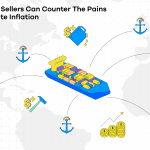
Experienced online sellers know that moving products is the key to any successful business. Still, despite the seller’s best efforts, some products don’t move. Sometimes, there’s too much inventory on a particular seasonal item. Other times, the next big trend was a passing fad.
Whatever the reason, if you are an online seller, learning to get rid of slow-moving products can be the difference between earning a profit and going out of business. Based on our experience with online sellers of all sizes, Descartes Sellercloud has compiled a list of five strategies you can use to get rid of excess inventory and keep your business moving forward:
1. Never Become Emotionally Attached to Your Inventory
The first step to moving excess inventory is to remember why you got into this business in the first place—for example, to make money buying and selling products. The key here is to remember the long game. Some products will bring quick profits, others will take more time, and still others might have to be sold at a loss.
You can’t sweat every single item. Stale products have to go. Often, this is the hardest step for sellers, who hate to lose money on an investment.
We feel your pain. However, that doesn’t let you off the hook. You must still develop a realistic perspective on the market value of your products. Use the 90-120-day rule as a guideline. You should be turning your inventory every 90 to 120 days. Beyond that point, it’s time to let the product go, even at a loss.
2. Add New Photos and Keyword Descriptions
That photo you took six months ago? Change it. Sometimes, all it takes for buyers to take a new look at your product is a little window dressing online. In terms of photo presentation, your product should fill up 85% of the frame. Make sure the lighting is excellent. Although it may seem like an insignificant change, Descartes Sellercloud has found that showcasing your items with high-quality photos can lead to a 20% jump in sales.
In addition to the visual presentation, remember to optimize your search terms regularly. Nearly all online sales begin with a buyer’s search. Take time to craft descriptions and titles that include well-placed keywords. Buyers think of keywords and keyword phrases, which can be discovered using keyword tools such as Google and other online tools.
If a particular product isn’t moving, it may simply be a matter of buyers not finding it. Revising your keywords regularly should be built into your company’s selling process. Sometimes, it helps to add seasons or holidays to your product descriptions.
3. Find Ways to Bundle Items Creatively
Some sellers, particularly those new to the business, may be tempted to run generic sales to move excess inventory. However, simply running a sale can backfire if the product still fails to move. Instead, online sellers stand a better chance of selling slow-moving products by engaging in creative bundling.
There are many ways to bundle products. Instead of selling one product at a discount, bundle the product into a specific line of items and run a sale on the entire group. For example, offer a 20% discount on all cameras or 10% off on all back-to-school items. Grouped items tend to generate more buzz than individual items.
Another way to move excess inventory is to bundle sellers with more popular items. Cosmetic companies will often create a bundled promotional kit, which includes a few non-selling or discontinued items. Buyers will buy the bundle for the item they want, and if the hot-selling item is popular enough, it may make up for the loss on the products that have not been moving.
4. Cut Prices Now, Rather than Later
An ancient parable states that even moving backward is still moving forward. Cutting prices is part of the cost of doing business. Of course, taking a 10% loss hurts, but it hurts a lot less when it’s done earlier rather than later. In addition, waiting too long often forces a seller to offer even deeper discounts.
Developing a decisive edge to your decision-making process will lead to greater profits in the long run. You are losing money every day, a product sits on your shelves unsold.
5. Remember, Cash Flow Is King
Along with decisively cutting prices when necessary, sellers should never forget that cash flow is the heart and soul of an online business. Your thinking should follow that flow. Avoid worrying about how much you paid for the product, and instead focus on depositing the cash in your account after selling excess inventory.
Every item that takes up inventory also prevents you from replacing it with a faster-selling item. This applies across the board, even to items that are one-of-a-kind or extremely rare.
Sellers who work from home sometimes think they can afford to hang on to certain items because their storage costs are low. This is a mistake. Online selling is about selling, period. Keep the cash flow going, and eventually, you will recoup losses on individual items.
These tips will help you get out of neutral and put your business back in gear.
Book a Descartes Sellercloud demo today.




